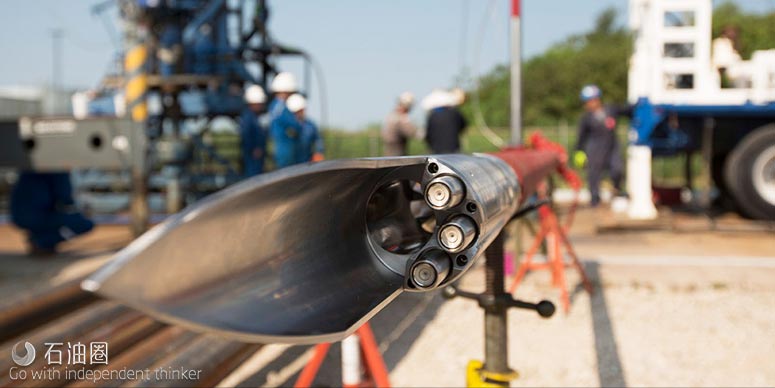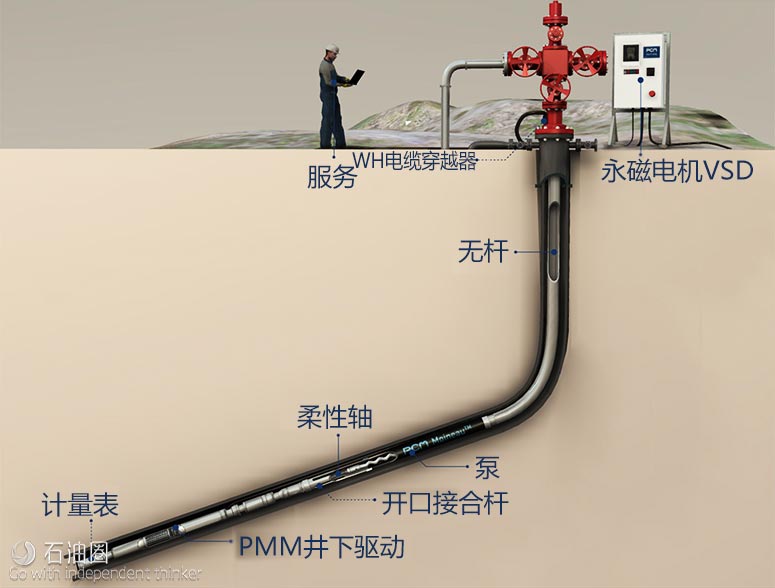Rig-less ESP system
Conventionally replacing ESPs to accommodate downhole changes or restore failed components requires rig or hoist interventions that cause production deferment and increased costs. The operation also increases HSE risks associated with complex well interventions.
The Schlumberger ZEiTECS Shuttle (Fig. 5) rigless ESP replacement system features a downhole electrical wet-connector that enables standard ESPs to be transported through tubing on wireline, coiled tubing or sucker rods and plugged into a downhole docking station—all without a rig or hoist. The rigless ESP replacement system minimizes production deferment, reduces operating costs, and HSE risks, while maximizing ESP run life by facilitating regular preventative maintenance. The shuttle also enables operators to exchange ESPs in response to changing well conditions instead of waiting for a failure.
The system has two principal assemblies: 1) the rig-deployed semi-permanent components, including a docking station; and 2) the riglessly retrievable components, including a standard ESP with a motor connector on the bottom and a slip-lock seal assembly on the top.
The docking station is deployed on the bottom of jointed tubing with cable clamped or banded to the outside and houses three electrical wet connectors (receptacles) to supply power to the standard, three-phase, AC, induction or permanent magnet motor. The docking station also has a facility to engage and rotate the motor connector, so that the wet connectors align, and a landing surface to bear the weight of the retrievable string and the reactive forces generated by the ESP. An offset through-bore allows reservoir access beneath.
The motor connector is deployed at the base of the retrievable string. The connector has three electrical wet plugs and an alignment spear that automatically aligns the connectors with those of the docking station.
Shuttle systems have been deployed successfully both on- and offshore around the world. This field-proven technology increases production uptimes and drastically reduces well lifecycle cost.
BHI’s rig-less deployed ESP system
The Baker Hughes TransCoil rigless deployed, coiled tubing ESP system—developed in partnership with Saudi Aramco—eliminates the need for a rig in fields where availability is a concern, or where high intervention costs limit artificial lift options, Fig 6. The system features an inverted ESP, with the motor connected directly to a new-type power cable configuration. This eliminates the traditional ESP power cable-to-motor connection, which improves overall system reliability. Unlike wireline-deployed ESPs, the fully retrievable ESP does not have an in-well “wet connection,” which requires a rig to pull and replace it, if the connection fails.
The system’s unique cable design extends the operating range to 12,000 ft. This compares favorably to traditional CT-deployed ESPs, which are limited to approximately 7,000 ft because, at greater depths, the weight of the power cable will cause it to collapse inside the CT, creating an electrical failure. The system can be installed in 4?-in. to 9-in. casing, in wells with flowrates up to 18,000 bpd. In mature offshore fields, where high intervention costs can limit the application of ESPs, the system can be deployed through the existing 4?-in. tubing, saving the time required to pull an existing completion.
Another advantage of the technology, compared to wireline-deployed ESPs, is that it can be installed through a deviation in the wellbore. This capability allows operators to land the ESP closer to the producing zone for greater reservoir pressure drawdown and reserve recovery.
In Khurais field, Saudi Aramco was looking for an alternative deployment method to reduce downtime and costs. The yearly rig schedule for the field made it difficult to arrange unplanned workovers, creating long lead times to retrieve and install the ESP system.
To solve the problem, the operator and service provider collaborated to develop a tool that would eliminate the rig, and address harsh downhole conditions. On its first installation, including the mobilization time of a CT unit, the JV TransCoil system successfully returned 8,000 bpd to production after a year of downtime. The rigless deployment reduced ESP installation time by 50%, compared to a rig-deployed system, and workover costs by more than 50%.
PCP DEVELOPMENTS
Depleted wells have a tendency to produce gas, which can cause problems on artificial lifting systems. ESPs often have difficulty handling wide and varying flows. Even progressing cavity pumps (PCP), which do not have the gas lock issues that plague ESPs, can be affected when the free gas at the intake pressure exceeds 20%. In wells with a high dogleg severity, the chance of equipment failure is even greater for rod-driven PCPs.
Combining two breakthrough technologies for difficult wells. PCM has created a highly-efficient electrical submersible PCP for difficult wells. The system contains two technologies, including a hydraulically regulated PCP (HRPCP) for high GOR wells, which is coupled with a permanent magnet motor (PMM), Fig. 7.
Associating a submersible permanent magnet motor with a submersible PCP creates a single artificial lift system that incorporates the benefits of a PCP pump with the advantages of an ESP-type completion. The rod-less system eliminates rod failure, tubing punctures or space-out issues associated with a traditional rod-driven PCP, especially in highly deviated wells. It also helps to reduce tubing losses generated by the initial rod string and avoid unnecessary energy losses from a surface drivehead. This advanced alternative PCP system outperforms ESPs, which can gas lock and suffer from premature failure, due to sand wear.
Since it is derived from PCP technology, the HRPCP is better equipped to handle sand, solids and viscous oil without issues. Its unique rotor is designed for better pressure distribution inside the pump. PCM patented hydraulic regulators are embedded in the rotor, providing equally distributed pressure gradient and temperature gradient along the rotor. Pump reliability and run life are improved significantly. As a result, even with erratic multiphase flow patterns, the HRPCP can maintain a very stable and smooth operating behavior, along with high run life, even in extremely high GVF environments.
Finally, switching from a traditional induction ESP motor to a PMM eliminates the need for an expensive, unreliable gearbox in the BHA, increasing system efficiency while reducing power consumption.
The system has been deployed successfully in the Middle East for lifting 17°API heavy crude. The pilot was installed with the pump settled at 83o in a highly deviated well that was experiencing excessive PCP failures. The system passed through a 14°/100 ft deviation with setting 1,010 ft depth. It has been running for two years without production disruptions, or decline, despite a high gas content.

 石油圈
石油圈



